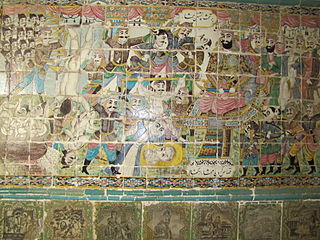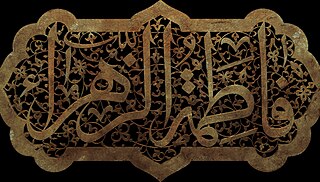
Ali ibn Abi Talib was the cousin and son-in-law of the Islamic prophet Muhammad, and was the fourth Rashidun caliph who ruled from 656 to 661, as well as the first Shia imam. Born to Abu Talib ibn Abd al-Muttalib and Fatima bint Asad, a young Ali was raised by his elder cousin Muhammad and was among the first to accept his teachings.
In Shia Islam, the Imamah is a doctrine which asserts that certain individuals from the lineage of the Islamic prophet Muhammad are to be accepted as leaders and guides of the ummah after the death of Muhammad. Imamah further says that Imams possess divine knowledge and authority (Ismah) as well as being part of the Ahl al-Bayt, the family of Muhammad. These Imams have the role of providing commentary and interpretation of the Quran as well as guidance.

The Alids are those who claim descent from Ali ibn Abi Talib, the fourth Rashidun caliph and the first imam in Shia Islam. Ali was also the cousin and son-in-law of the Islamic prophet Muhammad. The main branches are the Hasanids and Husaynids, named after Hasan and Husayn, the eldest sons of Ali from his marriage to Fatima, the daughter of Muhammad. As the progeny of Muhammad, they are revered by all Muslims. The Alids have led various movements in Islam, and a line of twelve Alids are the imams in Twelver Shia, the largest Shia branch.
Hāshim ibn ʿAbd Manāf, born ʿAmr al-ʿUlā, was the great-grandfather of the Islamic prophet Muhammad and the progenitor of the ruling Banu Hashim clan of the Quraysh tribe in Mecca. At some point in his life before his father's death, 'Amr chose for himself the name Hāshim, as it was the name God used for Abraham. The narrations from Islamic hagiographists to explain this name change are varied: A narration suggests that `Amr was called Hashim because Hashim translates as pulverizer in Arabic. As a generous man, he initiated the practice of providing crumbled bread in broth that was later adapted for the pilgrims to the Ka'aba in Mecca. Another narration claims the name derives from the Arabic root Hashm, to save the starving, because he arranged for the feeding of the people of Mecca during a seasonal famine, and he thus came to be known as "the man who fed the starved".
Al-Qāʾim, al-Qaim, or al-Ḳāʾim may refer to:

Al-Mukhtar ibn Abi Ubayd al-Thaqafi was a pro-Alid revolutionary based in Kufa, who led a rebellion against the Umayyad Caliphate in 685 and ruled over most of Iraq for eighteen months during the Second Fitna.

Hadith studies consists of several religious scholarly disciplines used by Muslim scholars in the study and evaluation of the Islamic hadith—i.e. the record of the words, actions, and the silent approval of the Islamic prophet, Muhammad.

The first to criticize the Islamic prophet Muhammad were his non-Muslim Arab contemporaries, who decried him for preaching monotheism, and the Jewish tribes of Arabia, for what they claimed were unwarranted appropriation of Biblical narratives and figures and vituperation of the Jewish faith. For these reasons, medieval Jewish writers commonly referred to him by the derogatory nickname ha-Meshuggah.

Fatima bint Muhammad, commonly known as Fatima al-Zahra', was the daughter of the Islamic prophet Muhammad and his wife Khadija. Fatima's husband was Ali, the fourth of the Rashidun Caliphs and the first Shia Imam. Fatima's sons were Hasan and Husayn, the second and third Shia Imams, respectively. Fatima has been compared to Mary, mother of Jesus, especially in Shia Islam. Muhammad is said to have regarded her as the best of women and the dearest person to him. She is often viewed as an ultimate archetype for Muslim women and an example of compassion, generosity, and enduring suffering. It is through Fatima that Muhammad's family line has survived to this date. Her name and her epithets remain popular choices for Muslim girls.
Abhala bin Ka'b al-Aswad al-Ansi, was a 7th-century leader of the Banu Ans tribe and a self-proclaimed prophet, one of the four major figures who were declared to be false prophets of the Wars of Apostasy.
Aisha bint Abi Bakr was Islamic prophet Muhammad's third and youngest wife, who married him in 620 at the age of 6 or 7.
Criticism of Twelver Shia Islam dates from the initial ideological rift among early Muslims that led to the two primary denominations of Islam, the Sunnis and the Shias. The question of succession to Muhammad in Islam, the nature of the Imamate, the status of the twelfth Shia Imam, and other areas in which Shia Islam differs from Sunni Islam have been criticized by Sunni scholars, even though there is no disagreement between the two sects regarding the centrality of the Quran, Muhammad, and many other doctrinal, theological and ritual matters. Shia commentators such as Musa al-Musawi and Ali Shariati have themselves, in their attempts to reform the faith, criticized practices and beliefs which have become prevalent in the Twelver Shia community.
Qusai ibn Kilab ibn Murrah, also spelled Qusayy, Kusayy, Kusai, or Cossai, born Zayd, was an Ishmaelite descendant of Abraham. Orphaned early on, he would rise to become chief of Mecca, and leader of the Quraysh tribe. He is best known for being an ancestor of the Islamic prophet Muhammad as well as the third and the fourth Rashidun caliphs, Uthman and Ali, and the later Umayyad, Abbasid, and Fatimid caliphs along with several of the most prominent Hashemite dynasties in the orient.

Musa ibn Ja'far al-Kazim was a descendant of the Islamic prophet Muhammad and the seventh imam in Twelver Shia Islam. Musa is often known by the title al-Kazim, apparently a reference to his patience and mild demeanor. He was born in 745 CE in Medina to Ja'far al-Sadiq, the sixth Shia imam, who died in 765 without publicly designating a successor to save his heir from the wrath of the Abbasid caliphs. The subsequent crisis of succession was eventually resolved in favor of al-Kazim, with a dissenting group, now known as the Isma'ilis, separating from the mainstream Shia.
Prophets in Islam are individuals in Islam who are believed to spread God's message on Earth and serve as models of ideal human behaviour. Some prophets are categorized as messengers, those who transmit divine revelation, most of them through the interaction of an angel. Muslims believe that many prophets existed, including many not mentioned in the Quran. The Quran states: "And for every community there is a messenger." Belief in the Islamic prophets is one of the six articles of the Islamic faith.
Yaʽfūr was a donkey used as a mount by the Islamic prophet Muhammad, who was said to have often ridden it without harness. There are many tales of this donkey but the most common would be that the donkey is recorded to have been a gift from the Byzantine governor of Egypt some time between 628 and 632 AD. According to a Shi'ite Islamic tradition, it had the power of speech and told Muhammad that it was the last of a line of donkeys ridden by prophets and was a descendant of the donkey ridden by Jesus in his triumphal entry into Jerusalem, which was also called Yaʽfūr. The tradition holds that Yaʽfūr committed suicide in despair after Muhammad died by throwing itself into a well, though these accounts are held to be unreliable in hadith studies. In the centuries after Muhammad's death, the donkey's name and symbolism was repeatedly adopted by Islamic religious figures and rulers.
The Battle of Fakhkh was fought on 11 June 786 between the forces of the Abbasid Caliphate and the supporters of a pro-Alid rebellion in Mecca under al-Husayn ibn Ali, a descendant of Hasan ibn Ali.
Umāma bint Ḥamza was a companion and first cousin of the Islamic prophet Muhammad.
Sulayman ibn Surad al-Khuza'i was a pro-Alid leader from Kufa, who led the Tawwabin movement during the Second Fitna to avenge the death of Husayn ibn Ali, a grandson of the Islamic prophet Muhammad. He had participated in battles during the First Fitna on the side of the fourth caliph Ali, although at occasions was disapproving of his decisions. After the death of Mu'awiya I, he was the most prominent of the Kufans who urged Ali's son Husayn to revolt. After the death of Husayn at the Battle of Karbala in 680, in which he failed to support Husayn, Ibn Surad and some other Alid partisans of Kufa sacrificed themselves in an attempt to avenge his death.







